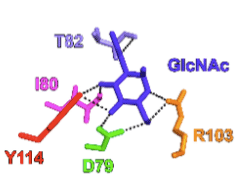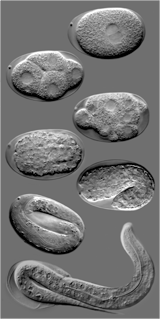Microbial Glycobiology
(in collaboration with Prof. Markus Aebi, ETH Zürich)
Link to Aebi lab:

C. elegans as a model system for pest control
Genetic analysis of the nematotoxicity of fungal lectins in C. elegans
Lectins are non-immunoglobin, carbohydrate-binding proteins without catalytic activity towards the recognized carbohydrate. Higher fungi express a variety of lectins with different substrate specificities: their function is usually unknown. In bacteria, plants and recently in animals, lectins have been shown to play a role in the defense against pathogens and parasites. We have found that several lectins of the homobasidiomycete Coprinopsis cinerea and other higher fungi display toxicity towards C. elegans and thus may be part of a lectin-mediated defense system of higher fungi against predators and parasites. Although the mechanism of toxicity is currently unclear, we hypothesize that clustering of multivalent glycoconjugates by oligomeric lectins is a key event triggering cell and organismic death. The idenitifcation of specific target glycans of these lectins might thus be of interest with regard to pest control. We are using forward genetic and biochemical tools to identify the target of nematotoxic lectins, and to understand their various mechanisms of toxicity.
Stutz K, Kaech A, Aebi M, Künzler M, Hengartner MO. Disruption of the C. elegans Intestinal Brush Border by the Fungal Lectin CCL2 Phenocopies Dietary Lectin Toxicity in Mammals. PLoS One. 2015 Jun 9;10(6):e0129381. doi: 10.1371/journal.pone.0129381. eCollection 2015.
Wohlschlager T, Butschi A, Grassi P, Sutov G, Gauss R, Hauck D, Schmieder SS, Knobel M, Titz A, Dell A, Haslam SM, Hengartner MO, Aebi M, Künzler M.Methylated glycans as conserved targets of animal and fungal innate defense. Proc Natl Acad Sci U S A. 2014 May 30
Schubert M, Bleuler-Martinez S, Butschi A, Wälti MA, Egloff P, Stutz K, Yan S, Wilson IB, Hengartner MO, Aebi M, Allain FH, Künzler M. Plasticity of the β-trefoil protein fold in the recognition and control of invertebrate predators and parasites by a fungal defence system.PLoS Pathog. 2012 May;8(5):e1002706.
Wohlschlager T, Butschi A, Zurfluh K, Vonesch SC, auf dem Keller U, Gehrig P, Bleuler-Martinez S, Hengartner MO, Aebi M, Künzler M.Nematotoxicity of Marasmius oreades agglutinin (MOA) depends on glycolipid binding and cysteine protease activity.J Biol Chem. 2011 Sep 2;286(35):30337-43.
Butschi A, Titz A, Wälti MA, Olieric V, Paschinger K, Nöbauer K, Guo X, Seeberger PH, Wilson IB, Aebi M, Hengartner MO, Künzler M: Caenorhabditis elegans N-glycan core beta-galactoside confers sensitivity towards nematotoxic fungal galectin CGL2. PLoS Pathog 2010, 6: e1000717.
Titz A, Butschi A, Henrissat B, Fan Y-Y, Hennet T, Razzazi-Fazeli E, Hengartner MO, Wilson IBH, Künzler M, Aebi M: Molecular basis for galactosylation of core fucose residues in invertebrates: identification of Caenorhabditis elegans N-glycan core alpha1,6-fucoside beta1,4-galactosyltransferase GALT-1 as a member of a novel glycosyltransferase family. J Biol Chem 2009, 284: 36223-36233.
